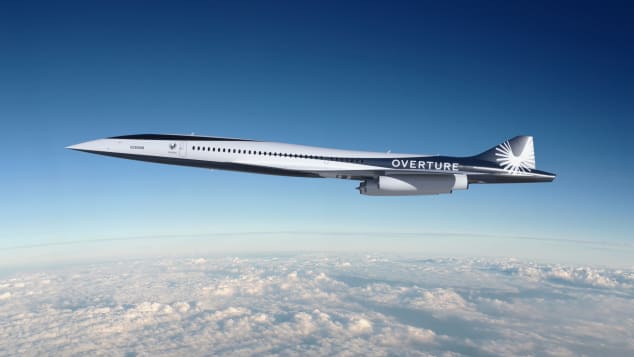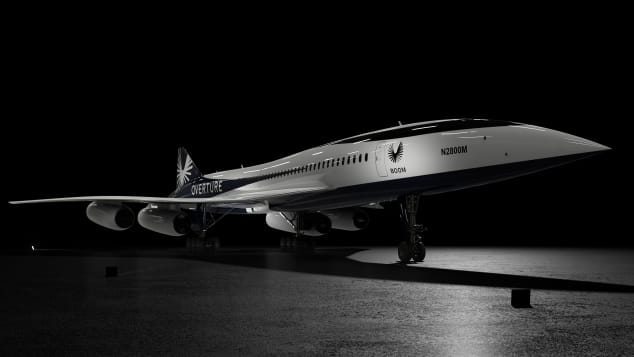Last summer United Airlines placed an order with Boom Aerospace for supersonic jets. Now American Airlines has placed an order, too.
- American claims they’ll have the biggest fleet of supersonic jets. United ordered 15 with an option for 35 more, American ordered 20 with an option for 40 more.
- American made a non-refundable deposit on the first 20. It’s unclear what non-refundable means: probably non-refundable in the case Boom Aerospace winds up in bankruptcy, but non-refundable if there’s never an engine for the plane?
- I would have at least expected a non-refundable deposit to have paid for an aircraft rendering in the airline’s livery..
- While United Airlines pilots met their carrier’s supersonic order with some excitement, the American Airlines pilots union is skeptical and says the airline should focus on the “here and now.” They have to do both, of course. The question is whether one distracts from the other.

Credit: Boom Aerospace

Credit: Boom Aerospace
Boom Aerospace unveiled the design of their Overture aircraft last month, however they still do not have an engine that will fly the plane supersonic so the projected 2025 rollout of the aircraft (and 2029 entry into passenger service) seems aggressive. American Airlines joint venture partner Japan Airlines is an investor in Boom.
Twenty years ago frequent flyers took advantage of an amazing deal to fly supersonic on the Concorde for ~ $1100 roundtrip:
- Buy 21 subscriptions to Inside Flyer magazine, earning 2500 Starwood points for each purchase
- Transfer those Starwood points to Qantas at 1:2 (with bonus, 20,000 Starwood points yielded 50,000 Qantas points back then)
- Qantas used to let you book Concorde for the same price as British Airways first class. Shortly thereafter Qantas increased the cost of premium cabin awards as much as 92%.
This was after Concorde’s one and only crash in 2000 but before its last flight in 2003. Air France flight AF4590 punctured a tire running over a piece of metal from a Continental DC-10 that had taken off before it. The tire exploded, and rubber from the tire hit the plane’s fuel tank and caused a fire. With only one operational engine the plane couldn’t gain altitude.
Since the retirement of Concorde there’s been no supersonic commercial air travel. It had competitors – the Soviet Tupolov nicknamed Konkordski, and the Boeing 2707 SST which was never completed. The first production version of the Tupolov Tu-144 crashed at the Paris Air Show in 1973, supposedly the plane was built based on stolen plans from the French and Americans but they had been fed fake plans.
It’s amazing that Concorde entered commercial service as long ago as 1976 yet its Mach 2 speeds haven’t been matched by new aircraft since. But Concorde took about 8 times as much fuel per passenger mile as a conventional jet, and the sonic booms it generated created backlash from voters.
Only one U.S. airline ever operated Concordes. Braniff leased planes from British Airways and Air France and flew domestically in 1979 and 1980 at subsonic speeds from Dallas to Washington Dulles where BA and Air France crews would take over for the onward journey to London and Paris.
Supersonic travel has been banned over the U.S. ostensibly due to noise but there weren’t specific noise limits, just a ban on the technology. The FAA finally changed its tune and though it’s taken a decade has become open to supersonic travel again. At the same time startups like Boom have been developing plans to fly at supersonic speeds with greater efficiencies than Concorde’s 1970s technology.
We may see new jets that can fly Mach 2.2 or 10% faster than Concorde, at best after 50 years we’re likely only looking at 10% more speed. Boom’s Overture aircraft, though, is projected to fly at Mach 1.7.
As long as supersonic travel is more expensive than subsonic, the market will be limited. And limited markets make it tough to recoup development and acquisition costs. Airlines have a hard time making money operating only a couple of planes of a type. The plane needs to be capable of flying long distances, fuel efficiently, and carry large numbers of passengers in order to be economical on a large scale.
Otherwise the market has to be able to support fares significantly higher than for subsonic transport. The ultimate question is: how much is shaving 3.5 hours off of a transatlantic flight worth, and to how many people?
In 10 years cars are supposed to drive themselves, and our kids will ask vexingly did people really used to drive themselves, and how was that possible without having accidents all the time? And in 10 years we may be flying across the Atlantic in 3 hours and across the Pacific in 5 hours.
United and American have both also placed orders for electric air taxis whose introduction is being pushed back years by FAA certification rules.


Only need 2,500,000 miles? Sign me up for the inaugural flight!
AA: we don’t have any original ideas. So we’ll copy others. ( and spend less than last year)
Supersonic jets are cool and development should occur for passenger travel but I’m skeptical that Boom will succeed.
One of the coolest things I ever found at a flea market for $5 is the 1966 Boeing SST Presentation Kit. Talk about ambitious, the 2707 was certainly that. You can see pictures of the kit here, not mine, but it’s identical. Not sure what possessed them to make the box that color, but it was 1966.
https://www.okeylofi.com/products/1966-boeing-sst-box-set
Love the concept, but doubt the economics will work for the airlines. Maybe they can get the acceptable premiums out of passengers on longer long hauls to Asia, but I am skeptical it will work for Europe.
There wont be a game changer until there is such a plane that can seat at least as much as a 777 or even a 787 and cost of operation is close to the same!
Boom is most often followed by Bust…
It would be awesome, however, I’m sure my budget couldnt afford ticket cost and by the time it happens I’ll be too old to care.
American also ordered 10 Concordes as orders or options. Where are they?
I’ve seen this movie before, as I’m old enough to remember the last time this was attempted in the U.S.
I’ll believe it when the first one flies its first revenue segment.
I’m certainly no airline expert but I’m skeptical it’s going to really pan out longterm. Business travelers would be the main target audience, so how many of those will pay a premium to shave off those hours? Especially with videoconference technology now so ubiquitous and reliable compared to the era of the Concorde. Sure there will be cases where supersonic is preferable for some industries and situations, but is it enough?
I guess it all comes down to the costs of operations. I guess if the costs are such that the airlines only need to price in only a slightly higher premium than J/F for TATL/TPAC, it will work.
I do hope I’m wrong and it all works out though.
There are flying prototypes of urban air taxis that are in flight test right now. That is not true of any passenger capable supersonic aircraft.
It is doubtful that there will be a large enough market for supersonic travel at prices that will cover costs.
Just like the Concorde, Boom will have to be operated by for-profit companies that cannot sustain repeated losses in any part of their businesses.
American and United have been locked in a battle of “follow the loser” for decades and both have financial track records to show for it. The only real recent difference is that American actually generated higher margins than United for the most recent quarter; Delta’s margins were just about twice what AA and UA produced while WN was even higher.
Airlines have gone all-in on marketing via limited investment in long-shot startups that are highly unlikely to produce marketable aircraft in the next decade. It seems almost certain that all the free press produces more and better marketing than an equal amount of spending on TV or print ads. It’s brilliant, but everyone should probably stop falling for it.
It’s American Airlines. They’ll put 197 basic economy seats on it and fly it from Orlando to Charlotte in 4 minutes, 45 times per day.
@Ryan – Videoconferencing is a great tool, reduces the need for some business travel, but it doesn’t substitute for being in the same room, sitting down for a meal with clients or colleagues. One can communicate across a videoconference, one does not establish a human-to-human relationship in the same way across one. And people really appreciate it when you take the effort to visit them in person. Not so much on what is basically a fancy telephone call. In theory, videoconferencing should have substituted for classrooms during the pandemic – turns out it didn’t.
@Doug – You’d be surprised at the amount of “free” press that results from spending on TV or print ads. What the news covers is not accidental – there is a lot of you scratch my back, I’ll scratch yours. Ever wonder why local news never reports negatively on car dealers? If they do, it’s about some crappy dealer with no ad budget on that station.
I’m 72 now so I don’t think I will be making that dream trip to Thailand. Maybe not ever.
American Airlines will soon be Numero Uno and I will be there as a Pakistani CK to witness this. My wife Donna is also a CK.